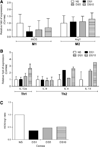Macrophage Phenotype in the Ocular Surface of Experimental Murine Dry Eye Disease
- PMID: 25772203
- PMCID: PMC4523394
- DOI: 10.1007/s00005-015-0335-0
Macrophage Phenotype in the Ocular Surface of Experimental Murine Dry Eye Disease
Abstract
To evaluate the phenotype of macrophages in the cornea and conjunctiva of C57BL/6 mice with induced experimental dry eye. C57BL/6 mice exposed to desiccating stress (DS) were evaluated at 1, 5, and 10 days and C57BL/6 mice maintained in non-stressed environment were used as controls. Whole eyes and adnexa were excised for histology or used for gene expression analysis. Location and phenotype of macrophages infiltrating the cornea and conjunctiva was evaluated by immunofluorescence analysis. Quantitative polymerase chain reaction evaluated macrophage markers and T cell-related and inflammatory cytokine expression in cornea and conjunctiva. Immunofluorescence staining demonstrated that macrophages reside in the conjunctiva of control and dry eye mice and their number did not change with DS. Real-time RT-PCR demonstrated that the level of M1 macrophage marker, iNOS, increased prominently in the conjunctiva at DS 10 days. In contrast, there was a non-significant decrease of the M2 marker Arg1 with DS. The levels of inflammatory cytokine, IL-12a mRNA transcript in the conjunctiva increased significantly at DS1 and decreased at DS5, while levels of IL-18 were significantly increased at DS 10. Macrophages reside in the ocular surface tissues of C57BL/6 mice. Although the number of macrophages in the conjunctiva does not change, evidence of inflammatory M1 activation after desiccating stress was observed. Better understanding of phagocyte diversity and activation in dry eye disease provide a basis for the development of phagocyte-targeted therapeutic strategies.
Conflict of interest statement
Figures



References
-
- Biswas SK, Mantovani A. Macrophage plasticity and interaction with lymphocyte subsets: cancer as a paradigm. Nat Immunol. 2010;11:889–896. - PubMed
-
- Chiang CS, Chen FH, Hong JH, et al. Functional phenotype of macrophages depends on assay procedures. Int Immunol. 2008;20:215–222. - PubMed
-
- De Paiva CS, Villarreal AL, Corrales RM, et al. Dry eye-induced conjunctival epithelial squamous metaplasia is modulated by interferon-gamma. Invest Ophthalmol Vis Sci. 2007;48:2553–2560. - PubMed
Publication types
MeSH terms
Substances
Grants and funding
LinkOut - more resources
Full Text Sources
Other Literature Sources
Research Materials
Miscellaneous

